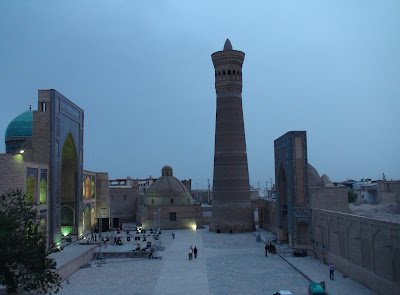
The Lyabi-Hauz.
The Lyabi-Hauz was dug in 1620 and became the biggest artificial reservoir in medieval Bukhara. It used to contain more than four thousand cubic meters of water which flowed from the Aryk of Shahrud ("Royal River"), to be supplied to the citizens of Bukhara.
SOURCE: Arapov A. V., Bukhara: Masterpieces of Central Asia, "SAN'AT" Press, Tashkent, 2006.

A statue of a camel on the bank of the Lyabi-Hauz.
Photo courtesy of Mohammad Asy'ari Mohamed Akhir.

The Khanaka of Nadir Divan-Begi, overlooking the Lyabi-Hauz.
The Khanaka of Nadir Divan-Begi is a Sufi khanaka (monastery) which was ordered to be built by Nadir Divan-Begi in 1619-1620.
SOURCE: Arapov A. V., Bukhara: Masterpieces of Central Asia, "SAN'AT" Press, Tashkent, 2006.

An ancient mulberry tree which was planted in 1477 on the bank of the Lyabi-Hauz.
Photo courtesy of Mohammad Asy'ari Mohamed Akhir.

The ancient mulberry tree.

An alley at the rear of the Poi-Kalyan.
Poi-Kalyan (Kalyan Ensemble) consists of Mosque of Kalyan, Madrasah of Miri-Arab and Madrasah of Amir Alim-Khan.
SOURCE: Arapov A. V., Bukhara: Masterpieces of Central Asia, "SAN'AT" Press, Tashkent, 2006.
The Minaret of Kalyan & the Mosque of Kalyan.
Minaret of Kalyan ("Great") was constructed in 1127 and acts as the main symbol of sacred Bukhara. The tower is 45.5 meters high. Inside the tower, there is a spiral staircase with 104 steps. Minaret of Kalyan is also known as "Tower of Death" where people sentenced to death were thrown down from its top, in the old days. Meanwhile, Mosque of Kalyan was constructed in the 15th century and became the major mosque of Bukhara for five centuries.
SOURCE: Arapov A. V., Bukhara: Masterpieces of Central Asia, "SAN'AT" Press, Tashkent, 2006.

A close-up look at the Minaret of Kalyan.

The beautifully-arranged bricks of the Minaret of Kalyan.

Inside the Mosque of Kalyan.
Photo courtesy of Syazwan Abdul Ghani.

The Madrasah of Miri-Arab.
Madrasah of Miri-Arab ("Prince of the Arabs") was constructed in 1535-1536. It operated for five centuries, had a break for two decades, and reopened in 1945.
SOURCE: Arapov A. V., Bukhara: Masterpieces of Central Asia, "SAN'AT" Press, Tashkent, 2006.

The Poi-Kalyan at dusk: the Madrasah of Miri-Arab (on the left), the Madrasah of Amir Alim-Khan (in the middle), the Minaret of Kalyan (in the middle) and the Mosque of Kalyan (on the right).
The Poi-Kalyan was being prepared for the anniversary celebration of Bukhara City in 2011.
Toki Tilpak-Furushon ("Mall of Headwear Sellers") was constructed in the 16th century. Its general architecture is a hexagon with a dome laying on six supports.
SOURCE: Arapov A. V., Bukhara: Masterpieces of Central Asia, "SAN'AT" Press, Tashkent, 2006.

The Toki Tilpak-Furushon from far.

The Mosque of Magoki-Attari.
The Mosque of Magoki-Attari is the most ancient Bukhara mosque. Fragments of foundations and carved decor found inside the mosque dated back to the 10th century. A hypothesis says that this mosque was founded on the place for a temple of Moon.

The Toki Sarrafon.
SOURCE: Arapov A. V., Bukhara: Masterpieces of Central Asia, "SAN'AT" Press, Tashkent, 2006.

The Toki Sarrafon.
Toki Sarrafon ("Mall of Money-Changers") was constructed in the 16th century. In the old days, the ancient Aryk of Shahrud ("Royal River") was flowing under this building.

The Mausoleum of the Samanids in the Samanids Park.


SOURCE: Arapov A. V., Bukhara: Masterpieces of Central Asia, "SAN'AT" Press, Tashkent, 2006.

The Mausoleum of the Samanids in the Samanids Park.
The Mausoleum of the Samanids is believed to be built at the turn of 9th and 10th centuries. It is an ancient cemetery for the royal family of the Samanids. A hypothesis says that this mausoleum is a transformation from a temple of Sun.
SOURCE: Arapov A. V., Bukhara: Masterpieces of Central Asia, "SAN'AT" Press, Tashkent, 2006.

Another view of the Mausoleum of the Samanids.
The general architecture of the mausoleum is a cube crowned by a hemisphere. The perfect harmony of its geometrical forms makes it recognized as one of the architectural masterpieces of the world heritage.
SOURCE: Arapov A. V., Bukhara: Masterpieces of Central Asia, "SAN'AT" Press, Tashkent, 2006.

The fine and brilliant brickwork of the Mausoleum of the Samanids.

The Chashma Ayub Mausoleum.
The Chashma Ayub Mausoleum was built in the 12th century in honor of Prophet Ayub (Prophet Job). According to a legend, Prophet Ayub had helped to bring into existence a water spring in the settlement when the region was facing a terrible drought.
SOURCE: http://www.bukhara.net/magictoday/chayub.htm

The Monument of Imam Al-Bukhari.

A store selling Bukhara handcrafted potteries.

